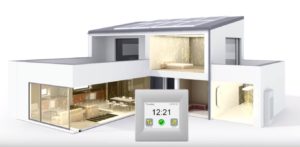Year 2019… we are within a stone throw away from horizon 2020, that has been the trend topic during the last decade regarding energy transition. Within the construction sector, 2020 is also the deadline for the European directive 2010/31/UE regarding the Near zero Energy Building (nZEB), mandatory for all new construction from the 1st of January 2021 (1st of January 2019 for public building).

But are we really prepared for this new energetic scenario and those new requirements?
We, in Ceilhit and Fenix Group, are working since 2015 with this target. From 2016, we started to run a pilot building with continuous monitoring from a laboratory from Prague University to optimize the heating systems according to those new requirements.
After more than two years of operations, we can confirm that electric radiant heating systems are the most suitable system within this new energetic and normative framework.
Near Zero Energy Buildings present a very effective thermal enclosure which ensure a very high thermic insulation to the whole building. As a consequence, the thermal losses are very limited and the heating system has to fit this new environment. Apart from the straightforward fact, that the global heat needed is low, the heating system must be able to react quickly and precisely to small and individual variations within each room.
Electric radiant heating systems are ideal in this environment thanks to their high reactivity and maximum flexibility. They are able to provide accurate deliveries of small amounts of heat independently in each room, matching both the individual heat losses localized in space and time (for instance, after room ventilation) and the many localized heat gains which are no longer neglectable (Presence of persons, sun periods, electric devices running, …), for optimal comfort and energy savings.
On the other hand, Near Zero energy buildings, per definition, require very low energy consumptions, which drastically change the payback calculations for heating systems. In this new type of building, heating systems with low initial investment, without maintenance costs and long life as electric radiant heating systems are much more economical, than traditional heating systems that would require a high initial investment that would hardly ever reach payback (apart from their added yearly maintenance costs).
Finally, the long-life span of our heating systems makes us look to the next horizon, 2050 in which they also fit perfectly: An electric heating system within an almost totally decarbonized environment, compatible with photovoltaic panels, and part of smart grid co-operation.


